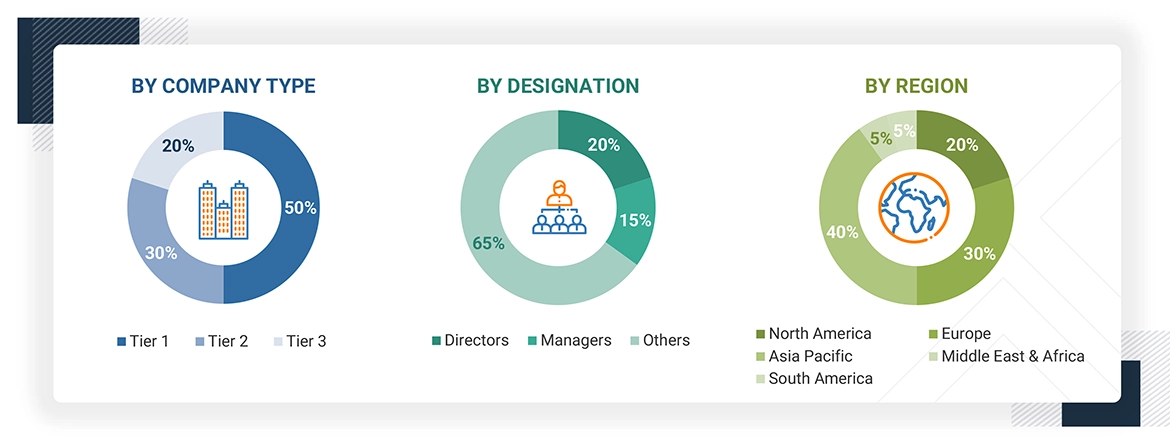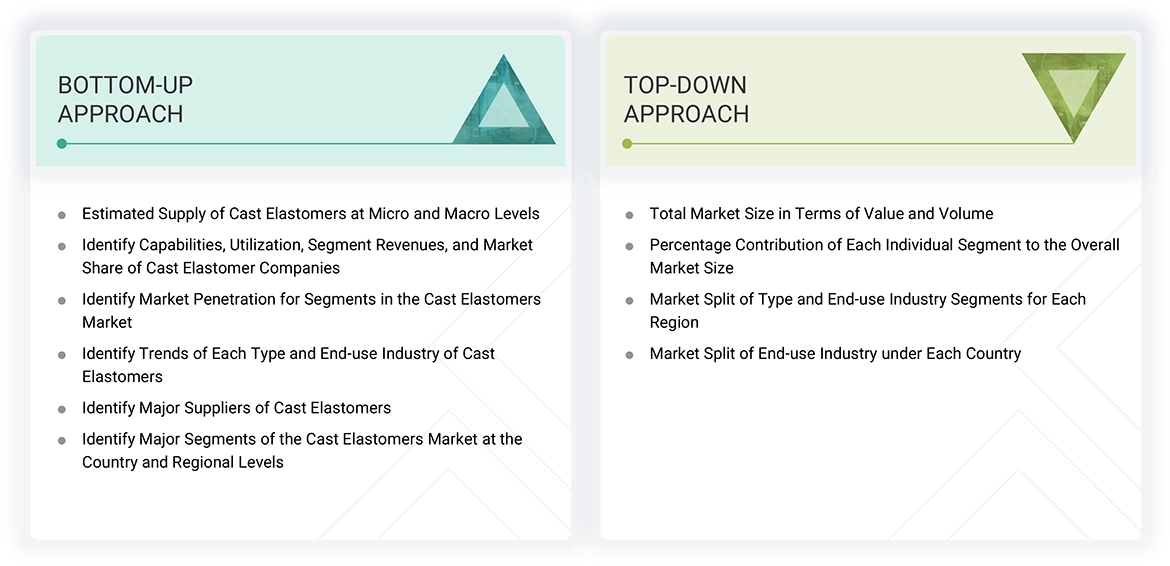The study involved four major activities in estimating the market size of the cast elastomers market. Exhaustive secondary research was done to collect information on the market, the peer market, and the parent market. The next step was to validate these findings, assumptions, and sizing with industry experts across the value chain through primary research. Both top-down and bottom-up approaches were employed to estimate the complete market size. Thereafter, the market breakdown and data triangulation procedures were used to estimate the market size of the segments and subsegments.
Secondary Research
Various secondary sources have been used in the secondary research process to identify and collect information for this study. These sources include annual reports, press releases, investor presentations of companies, white papers, certified publications, trade directories, articles from recognized authors, gold-standard and silver-standard websites, and databases. Secondary research has been used to obtain key information about the industry’s value chain and monetary chain, the total pool of key cast elastomer market players, classification and segmentation according to industry trends to the bottom-most level, and regional markets. It was also used to obtain information about key developments from a market-oriented perspective.
Primary Research
The cast elastomers market comprises several stakeholders in the value chain, including raw material suppliers, manufacturers, and end users. Various primary sources from the supply and demand sides of the market have been interviewed to obtain qualitative and quantitative information. The primary interviewees from the demand side include key opinion leaders in end-use sectors. The primary sources from the supply side include manufacturers, associations, and institutions involved in the cast elastomers market industry.
Primary interviews were conducted to gather insights such as market statistics, revenue data collected from the products and services, market breakdowns, market size estimations, market forecasting, and data triangulation. Primary research also helped in understanding the various trends related to type, end-use industry, and region. Stakeholders from the demand side, such as CIOs, CTOs, and CSOs, were interviewed to understand the buyer’s perspective on the suppliers, products, component providers, and their current usage of cast elastomers and future outlook of their business, which will affect the overall market.
The breakdown of profiles of the primary interviewees is illustrated in the figure below:

Note: Tier 1, Tier 2, and Tier 3 companies are classified based on their market revenue in 2024, which is available in the public domain, their product portfolios, and their geographical presence.
Other designations include sales representatives, production heads, and technicians.
To know about the assumptions considered for the study, download the pdf brochure
Market Size Estimation
The top-down approach was used to estimate and validate the size of various submarkets for the cast elastomers market by region. The research methodology used to estimate the market size included the following steps:
-
The key players in the industry have been identified through extensive secondary research.
-
The supply chain of the industry has been determined through primary and secondary research.
-
All percentage shares, splits, and breakdowns based on type, end-use industry, and region were determined using secondary sources and verified through primary sources.
-
All possible parameters that affect the markets covered in this research study were accounted for, viewed in extensive detail, verified through primary research, and analyzed to get the final quantitative and qualitative data. This data was consolidated and added with detailed inputs and analysis, and presented in this report.

Data Triangulation
After arriving at the total market size from the estimation process above, the overall market has been split into several segments and subsegments. To complete the overall market engineering process and arrive at the exact statistics for all the segments and subsegments, the data triangulation and market breakdown procedures have been employed, wherever applicable. The data has been triangulated by studying various factors and trends from both the demand and supply sides. Along with this, the market size has been validated by using both the top-down and bottom-up approaches and primary interviews. Hence, for every data segment, there have been three sources: the top-down approach, the bottom-up approach, and expert interviews. The data was assumed correct when the values arrived from the three sources matched.
Market Definition
Cast elastomers, which are polyurethane-based materials, are produced from a liquid casting process that generates very tough, flexible, and abrasion-resistant components. Cast elastomers are designed by polymerizing diisocyanates with polyol and curing agent while allowing for the flexibility of hardness, elasticity, and chemical resistance to be tailored. This flexibility makes cast elastomers suitable for applications under high-stress situations. The rising demand for cast elastomer products across all industry sectors, including automotive, mining, oil & gas, and industrial manufacturing, is leading to global expansion of this market. Products made of cast elastomers include wheels, rollers, seals, and linings, and mechanical strength and resistance to abrasion are critical characteristics of cast elastomers used in these products. The continued growth of electric vehicles, industrial automation, and mining activities further fuels the cast elastomers market. The Asia Pacific region leads in sales volume due to robust manufacturing activity, particularly in China and India.
Stakeholders
-
Cast Elastomer Manufacturers
-
Cast Elastomer Traders, Distributors, and Suppliers
-
Raw Type Suppliers
-
Government and Private Research Organizations
-
Associations and Industrial Bodies
-
R&D Institutions
-
Environmental Support Agencies
Report Objectives
-
To define, describe, and forecast the size of cast elastomers in terms of value and volume
-
To provide detailed information regarding the major factors (drivers, opportunities, restraints, and challenges) influencing the growth of the market
-
To estimate and forecast the market size based on type, end-use industry, and region
-
To forecast the size of the market with respect to major regions, namely, North America, Europe, Asia Pacific, the Middle East & Africa, and South America, along with their key countries
-
To strategically analyze micromarkets with respect to individual growth trends, prospects, and their contribution to the overall market
-
To analyze opportunities in the market for stakeholders and provide a competitive landscape of market leaders
-
To track and analyze recent developments such as product launches, expansions, investments, collaborations, and partnerships in the market
-
To strategically profile key market players and comprehensively analyze their core competencies



Growth opportunities and latent adjacency in Cast Elastomers Market